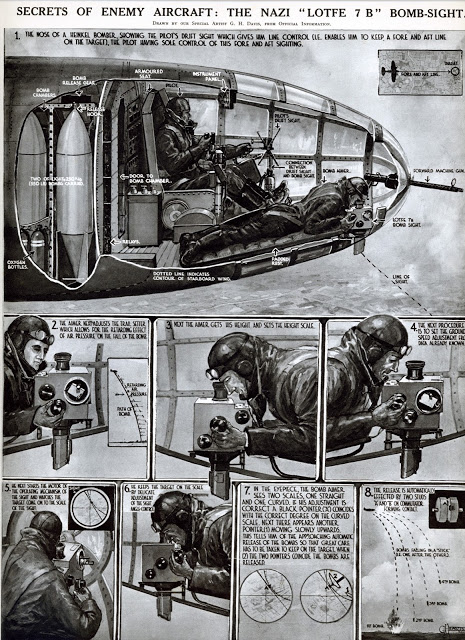
Until late 1943, the Norden bombsight was always protected by exceptionally heavy security. Sights were normally stored in air-conditioned, dustproof vaults that were patrolled by armed guards. During training, USAAF bombardiers had to swear a solemn oath to guard the secret weapon with their lives, and they were responsible for destroying it in the event of an emergency landing behind enemy lines. Whenever a bombardier or ordnance technician carried a sight out to an aircraft, two armed guards accompanied him.
After hundreds of Norden-equipped bombers were shot down over enemy territory during 1943, Allied officials knew that the Germans had surely studied the bombsight and learned its secrets. As a result, security was finally relaxed. When the war ended, details of the ingenious device were finally made public. But U. S. intelligence experts received a shock when they interrogated Luftwaffe personnel: The Germans had known the bombsight’s secrets even before the war, thanks to a spy at Norden.
Herman W. Lang, a naturalized U. S. citizen, had been employed as a draftsman and inspector at the Norden factory during the 1930s. American authorities didn’t know that he had served as Nazi stormtrooper in Germany between 1923 and 1927. Recruited as a member of the Duquesne Spy Ring, in 1938 Lang gained access to the plans for the bombsight and hand-copied the blueprints, which were then smuggled to Germany via ocean liner. He traveled to Germany for a “vacation” to assist Luftwaffe technical experts, receiving 10,000 Reichsmarks for his efforts. Lang returned to his job in America, but was later betrayed by a double agent, convicted of espionage and sentenced to 18 years in prison.
The Germans built a mock-up of the Norden sight and compared it to the new Lotfernrohr 7, or Lotfe 7, bombsight then being used by the Luftwaffe. The Lotfe 7 was similar in operation to the Norden, but much simpler and easier to operate. It consisted of a single metal casing holding the majority of the mechanism, with a tube extending out the bottom containing a mirror that reflected the image of the target into a small telescope in the box. The mechanisms within combined the functions of the Norden’s stabilizer and optics, moving the mirror to stabilize the image, as well as tracking the target. The Lotfe 7’s controls were also simpler than the Norden’s, consisting mainly of three large knobs to adjust aim.
The Carl Zeiss Lotfernrohr 7 (Lot meant “Vertical” and Fernrohr meant “Telescope”), or Lotfe 7, was the primary series of bombsights used in most Luftwaffe level bombers, similar to the United States’ Norden bombsight, but much simpler to operate and maintain.
Several models were produced and eventually completely replaced the simpler Lotfernrohr 3 and BZG 2 bombsights. The Lotfe 7C, appearing in January 1941, was the first one to have gyroscopic stabilization.
The Norden consisted of two primary parts, the optical system, and a large stabilization platform. Both were complex and had to be separately maintained to keep them operational.
German instruments were actually fairly similar to the Norden, even before World War II. In the Lofte 7, a similar set of gyroscopes provided a stabilized platform for the bombardier to sight through, although the more complex interaction between the bombsight and autopilot of the Norden was not used.
The Lotfe 7 was dramatically simpler, consisting of a single metal box containing the vast majority of the mechanism, with a tube (Rohr) extending out the bottom with a mirror that reflected the image of the target into a small telescope in the box.
Operation was fairly similar to the Norden. The bombardier would first locate the target in the bombsight and continue to adjust the dials until it remained motionless in the eyepiece. This allowed the bombsight to calculate the wind speed from the cancelled out drift rate, which in turn allowed to make an accurate calculation of groundspeed.
Unlike the Norden, the Lotfe 7 could view targets directly in front of the aircraft, so the bombardier could use the real target for adjustments, rather than having to “tune” the instruments on a test target located closer to the aircraft. The bombsight could be used against targets 90° to 40° in front of the aircraft, and up to 20° on either side.
On final approach, the autopilot was engaged, while the bombsight adjusted the flight path in response to last-minute changes by the bombardier. Bomb release was normally automatic in order to reduce timing errors.
The Lotfe 7 was normally installed near the nose of the aircraft with the mirror tube projecting through the fuselage to the outside of the aircraft.
In most installations, like those in the Junkers Ju 88 or Heinkel He 111, the tube ended in a fairing under the fuselage with a protruding flat window in front.
In other cases, like the Arado Ar 234 or the prototype bomber conversions of the Messerschmitt Me 262, the tube was open to the air, mounted so the mirror window was almost flush with the fuselage line.
The Luftwaffe decided their Lotfe 7 was better than the Norden and gave the American device no further consideration. So despite years of extraordinary efforts by U. S. military and civilian authorities to keep the Norden bombsight secret, America’s secret weapon was never secret-except to the American public.